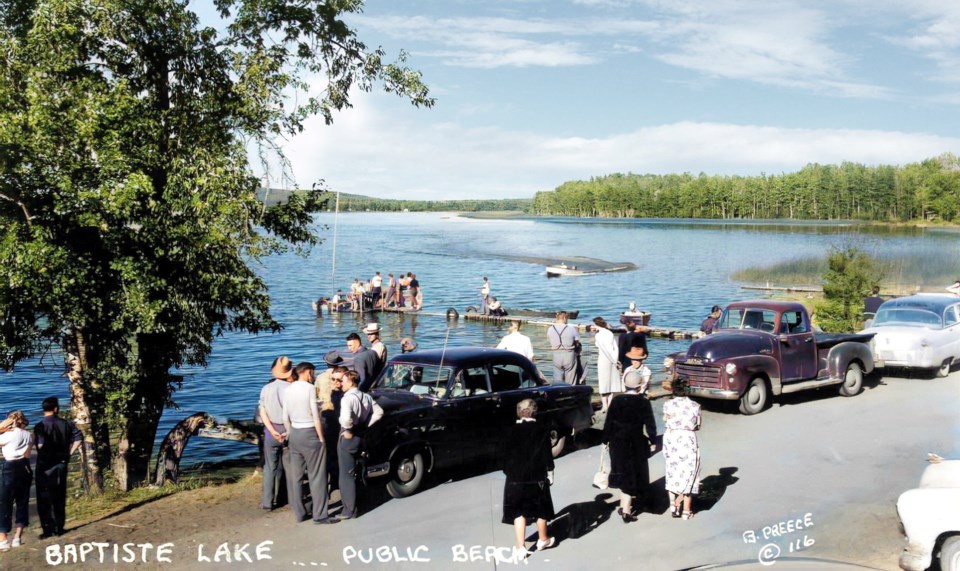ATHABASCA – Several elephants once frolicked in the waters of Island Lake, probably something that will never be seen again.
It was during a stopover by a circus outfit on its way to Slave Lake in 1959, who stopped to water the living attractions.
“Imagine the excitement when seven circus elephants smelled or saw the lake from their cages and started trumpeting!” wrote Gail White in Island Lake Ripples and Reflections, which was published in 2005 by the Island Lake Historical Society.
“They were unloaded one at a time. Kids and adults alike stampeded over to the main dock by boat and car to enjoy the unusual excitement.”
There are pictures to prove it however they haven’t made their way to the digital storage of the Athabasca Archives.
That’s one small, but interesting part of the history of the summer village and the Athabasca region. The summer villages of Island Lake and South Baptiste are just two of the communities that sprung up in the area, but the question of how these small communities came to be what they are today still stands.
For much of the time people have lived on these two lakes, they were close to self-sufficient, containing their own stores, post office, school, and even a garage.
The first settlers to build their homes around the lakes were the Métis, coming to Baptiste Lake specifically in the mid-1880s, while Baptiste Lake itself was named after early settler Baptiste Majeau.
“[They] followed the Lac La Biche River to the Athabasca River then travelled upstream to the mouth of Baptiste Creek. Here they disembarked and went overland to the southwest of Baptiste Lake,” according to the historical book From Out of the Wilderness, published by the Eight Horizons Historical Society in 1986, which details much of the history of Baptiste Lake, Island Lake, and the surrounding areas.
Over the course of the following 40 years, Athabasca and the surrounding areas saw a huge growth, mostly due to the agricultural opportunities available.
“This is an excellent mixed farming country, well-watered by numerable streams, with a considerable amount of flat open land of good quality ready for the plow,” Charles W. Noddings wrote to the Athabasca Echo in the September 4, 1911, edition.
“It is a blending of woodland, water, and prairie, which would be hard to beat anywhere, — a veritable Killarney and someday destined to become a pleasure resort for your great city,” he continued.
By 1919, a Baptiste Lake School was built for the 15 students of school age “who, if they wanted any education would have to pay room and board as well as a monthly fee to attend any other school,” as another excerpt from From Out of the Wilderness noted.
With the building of the school, the community also had a place to host activities of all sorts, ranging from picnics to political meetings. Soon after, a second school was built to the north of Baptiste Creek which did not yet have a bridge to allow for crossing. This school, known as Grosmont School, was too a centre for the community.
“Besides school affairs and dances, it was used for Alberta Wheat Pool meetings and a polling station. The Anglican Church services with Archdeacon Little were held in the old school,” From Out of the Wilderness states.
Grosmont also became known for its post office which was built in 1912 and remained open until 1970, and its community hall and ball diamond which has been renovated since its opening in the late 1920s and still is in use.
As the areas around these two lakes grew, so did the need for official recognition as summer villages.
“The Summer Village of Island Lake was the brainchild of its founder, George Meyer,” White also wrote.
Her father was responsible for building the Island Lake Lodge.
“In addition to the dance pavilion and attached restaurant, he built and operated a general store that offered propane, groceries and auto services at competitive rates. Other services available were boat rentals, a concession at the beach, supervised swimming, ice, fish-cleaning and cabin rentals.”
These amenities were the centre of the Summer Village of Island Lake when it was first established in 1958.
Over the years, the lakes have drawn all sorts of attractions as the summer villages have grown with both permanent and seasonal residents and continue to be big draws for visitors as well, whether they come for the scenery and recreation, or the many events that take place throughout the summer season.


